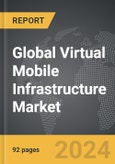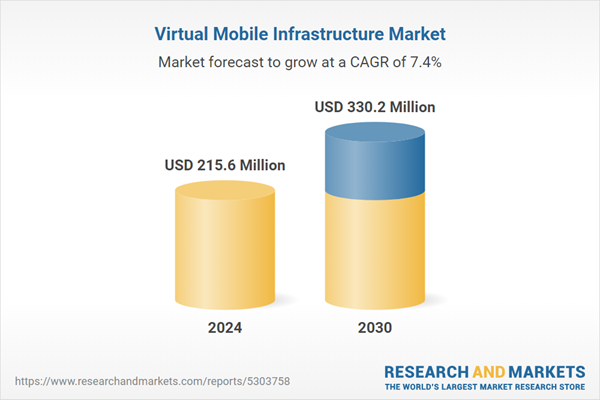Global Virtual Mobile Infrastructure (VMI) Market - Key Trends & Drivers Summarized
What Is Virtual Mobile Infrastructure (VMI), and Why Is It So Crucial in Modern IT Solutions?
Virtual Mobile Infrastructure (VMI) is a technology that enables mobile applications to run on virtual machines in a centralized server environment, allowing users to access these apps remotely from any device through a secure virtual session. Unlike traditional mobile management solutions, VMI separates the mobile app's execution from the device, which means that no data is stored locally on the user's device. This makes VMI particularly valuable for industries with stringent security requirements, such as finance, healthcare, government, and enterprises that require secure remote work environments.The importance of VMI lies in its ability to enhance data security, simplify mobile device management (MDM), and support Bring Your Own Device (BYOD) policies without compromising security. By running apps on a virtual server rather than the end device, VMI minimizes the risk of data leakage and malware attacks, as sensitive information remains within the server infrastructure. Additionally, VMI offers a consistent user experience across devices, making it easier for enterprises to manage mobile apps, control access, and ensure compliance with regulatory requirements. As remote work becomes more prevalent and cybersecurity threats continue to evolve, VMI has emerged as a crucial solution for organizations seeking secure, scalable, and device-agnostic mobile access.
How Are Technological Advancements Shaping the Virtual Mobile Infrastructure (VMI) Market?
Technological advancements have significantly enhanced the functionality, performance, and security of Virtual Mobile Infrastructure (VMI), driving innovation across various sectors. One of the major developments is the integration of VMI with cloud computing platforms, which has improved the scalability, reliability, and flexibility of VMI solutions. Cloud-based VMI allows enterprises to deploy and manage mobile apps more efficiently, offering faster access, reduced latency, and lower infrastructure costs. This cloud integration supports seamless updates, centralized management, and improved disaster recovery, making VMI more adaptable to changing business needs.Advancements in network technologies, such as 5G and high-speed Wi-Fi, have further improved the performance of VMI. Faster network speeds reduce latency in virtual sessions, providing users with a more responsive and reliable experience when accessing mobile apps through VMI. These advancements are particularly important for applications requiring real-time data processing, such as financial trading, telemedicine, and remote industrial operations. The combination of VMI with edge computing is also enhancing performance by bringing computational power closer to the user, which reduces data transfer delays and improves the efficiency of virtual mobile sessions.
The integration of artificial intelligence (AI) and machine learning (ML) into VMI systems has enhanced security, user experience, and application optimization. AI-powered analytics can monitor user behavior, detect anomalies, and flag potential security threats in real-time, further strengthening VMI's security capabilities. AI also enables dynamic resource allocation in virtual environments, improving the efficiency of mobile app performance by adjusting resource use based on demand and usage patterns. Additionally, advancements in endpoint security technologies, such as multi-factor authentication (MFA) and biometric verification, have been integrated into VMI solutions, enhancing access control and reducing the risk of unauthorized access. These technological innovations not only expand the capabilities of VMI but also align with broader trends toward secure, scalable, and flexible enterprise mobility solutions.
What Are the Emerging Applications of Virtual Mobile Infrastructure Across Different Industries?
Virtual Mobile Infrastructure (VMI) is finding expanding applications across a wide range of industries, driven by the need for secure and flexible remote access to mobile applications. In the financial services sector, VMI is used to provide secure access to banking apps, trading platforms, and customer management systems, ensuring compliance with stringent regulatory requirements. By keeping sensitive financial data within secure virtual environments, VMI helps banks and financial institutions mitigate the risk of data breaches, malware attacks, and insider threats. This makes VMI an ideal solution for financial advisors, traders, and remote workers who need secure access to sensitive information from mobile devices.In the healthcare sector, VMI is increasingly used to enable secure access to electronic health records (EHRs), telemedicine applications, and patient management systems. Healthcare professionals can access patient data remotely while ensuring compliance with data protection regulations like HIPAA. VMI ensures that no patient data is stored on personal devices, reducing the risk of data breaches and protecting patient confidentiality. For healthcare organizations adopting telehealth solutions, VMI offers a secure, centralized platform that supports remote consultations, diagnostics, and data sharing.
In the government and defense sectors, VMI is employed to secure sensitive communications, documents, and mission-critical applications. Government employees and military personnel can use VMI to access classified information remotely while ensuring that data remains within secure networks, preventing unauthorized access or leaks. In the manufacturing and industrial sectors, VMI enables secure remote management of operational technology (OT) systems, supporting IoT device control, production monitoring, and equipment maintenance from mobile devices. The expanding applications of VMI across these industries underscore its critical role in enhancing security, ensuring compliance, and supporting flexible, remote access to mobile apps.
What Drives Growth in the Virtual Mobile Infrastructure (VMI) Market?
The growth in the Virtual Mobile Infrastructure (VMI) market is driven by several factors, including increasing demand for secure remote work solutions, rising cybersecurity threats, and growing adoption of BYOD policies across enterprises. One of the primary growth drivers is the shift toward remote and hybrid work models, which has accelerated due to the COVID-19 pandemic. As organizations adapt to new work environments, the need for secure, scalable, and device-agnostic mobile access has grown, making VMI a critical solution for ensuring seamless and safe remote work.The rise in cybersecurity threats, such as data breaches, ransomware attacks, and malware targeting mobile devices, has further fueled demand for VMI. By keeping sensitive data within virtual servers and off personal devices, VMI provides a robust layer of security that protects organizations from common vulnerabilities associated with mobile device use. This level of security is particularly important for industries like finance, healthcare, and government, where data protection regulations are stringent and compliance is mandatory.
The increasing adoption of Bring Your Own Device (BYOD) policies in enterprises has also contributed to the growth of VMI. As organizations encourage employees to use personal devices for work, VMI offers a solution that supports BYOD while ensuring data security and compliance. VMI enables organizations to provide secure access to corporate apps without compromising device security or user privacy, making it an attractive option for businesses seeking to balance security with employee convenience.
With ongoing advancements in cloud computing, AI integration, and network technologies, the VMI market is poised for robust growth. These trends, combined with the growing need for flexible, secure, and efficient remote access solutions, make VMI a vital component of modern enterprise mobility strategies focused on enhancing cybersecurity, supporting remote work, and streamlining mobile app management.
Report Scope
The report analyzes the Virtual Mobile Infrastructure market, presented in terms of market value (US$ Thousand). The analysis covers the key segments and geographic regions outlined below.- Segments: Component (Platforms, Services); Deployment (On-Premise, Cloud); Vertical (BFSI, IT & Telecom, Healthcare, Manufacturing, Government, Other Verticals).
- Geographic Regions/Countries:World; United States; Canada; Japan; China; Europe (France; Germany; Italy; United Kingdom; and Rest of Europe); Asia-Pacific; Rest of World.
Key Insights:
- Market Growth: Understand the significant growth trajectory of the Platforms Component segment, which is expected to reach US$218.2 Million by 2030 with a CAGR of a 7.2%. The Services Component segment is also set to grow at 7.7% CAGR over the analysis period.
Why You Should Buy This Report:
- Detailed Market Analysis: Access a thorough analysis of the Global Virtual Mobile Infrastructure Market, covering all major geographic regions and market segments.
- Competitive Insights: Get an overview of the competitive landscape, including the market presence of major players across different geographies.
- Future Trends and Drivers: Understand the key trends and drivers shaping the future of the Global Virtual Mobile Infrastructure Market.
- Actionable Insights: Benefit from actionable insights that can help you identify new revenue opportunities and make strategic business decisions.
Key Questions Answered:
- How is the Global Virtual Mobile Infrastructure Market expected to evolve by 2030?
- What are the main drivers and restraints affecting the market?
- Which market segments will grow the most over the forecast period?
- How will market shares for different regions and segments change by 2030?
- Who are the leading players in the market, and what are their prospects?
Report Features:
- Comprehensive Market Data: Independent analysis of annual sales and market forecasts in US$ Million from 2024 to 2030.
- In-Depth Regional Analysis: Detailed insights into key markets, including the U.S., China, Japan, Canada, Europe, Asia-Pacific, Latin America, Middle East, and Africa.
- Company Profiles: Coverage of players such as Avast Software, Fortinet, Genymobile, Intelligent Waves, Nubo and more.
- Complimentary Updates: Receive free report updates for one year to keep you informed of the latest market developments.
Some of the 36 companies featured in this Virtual Mobile Infrastructure market report include:
- Avast Software
- Fortinet
- Genymobile
- Intelligent Waves
- Nubo
- Prescient Solutions
- Pulse Secure
- Raytheon
- Sierraware
- Trend Micro
This edition integrates the latest global trade and economic shifts into comprehensive market analysis. Key updates include:
- Tariff and Trade Impact: Insights into global tariff negotiations across 180+ countries, with analysis of supply chain turbulence, sourcing disruptions, and geographic realignment. Special focus on 2025 as a pivotal year for trade tensions, including updated perspectives on the Trump-era tariffs.
- Adjusted Forecasts and Analytics: Revised global and regional market forecasts through 2030, incorporating tariff effects, economic uncertainty, and structural changes in globalization. Includes historical analysis from 2015 to 2023.
- Strategic Market Dynamics: Evaluation of revised market prospects, regional outlooks, and key economic indicators such as population and urbanization trends.
- Innovation & Technology Trends: Latest developments in product and process innovation, emerging technologies, and key industry drivers shaping the competitive landscape.
- Competitive Intelligence: Updated global market share estimates for 2025, competitive positioning of major players (Strong/Active/Niche/Trivial), and refined focus on leading global brands and core players.
- Expert Insight & Commentary: Strategic analysis from economists, trade experts, and domain specialists to contextualize market shifts and identify emerging opportunities.
Table of Contents
Companies Mentioned (Partial List)
A selection of companies mentioned in this report includes, but is not limited to:
- Avast Software
- Fortinet
- Genymobile
- Intelligent Waves
- Nubo
- Prescient Solutions
- Pulse Secure
- Raytheon
- Sierraware
- Trend Micro
Table Information
| Report Attribute | Details |
|---|---|
| No. of Pages | 222 |
| Published | December 2025 |
| Forecast Period | 2024 - 2030 |
| Estimated Market Value ( USD | $ 215.6 Million |
| Forecasted Market Value ( USD | $ 330.2 Million |
| Compound Annual Growth Rate | 7.4% |
| Regions Covered | Global |









